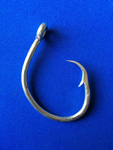 Question:
Question: What is a non-offset circle hook?
Answer:
Non-offset circle hooks are generally defined as a hook with the point turned perpendicularly back to the shank.
Question: How do non-offset circle hooks work?
Answer: It is important to not strike (or
set the hook) when the fish bites, but rather just reel in. The act of striking while using a circle hook often results in the hook being pulled out of the fish altogether.
Question: How do I fish correctly with a non-offset circle hook?
Answer: You want to give the fish line, fish with a slack line so fish can run with bait. A circle hook works when a fish has swallowed the bait and as he swims away the line tightens and the line moves to the corner of the mouth, the hook follows and engages in the corner of the mouth. DO NOT ATTEMPT TO SET HOOK, ALLOW FISH TO RUN WITH BAIT.
Question: What is a J-hook?
Answer: J-hooks are shaped like the letter "J" with point parallel to the shaft of the hook. J-hooks are traditionally used for fishing with natural bait.
 Question: What’s the difference between a circle hook compared to J-hook?
Question: What’s the difference between a circle hook compared to J-hook?
Answer: J-hooks are the type of hook traditionally used for fishing with natural bait. When fishing with a J-hook, the angler "sets" the hook by jerking up on the rod when he feels a bite. If the fish eats by inhaling its entire prey, this may cause the fish to be hooked in the esophagus or gut. While circle hooks are defined by the Atlantic States Marine Fisheries Commission as "a non-offset hook with the point turned perpendicularly back to the shank." (Marine Resource Research Institute)
Question:
How is using a circle hook any different than a J-hook?
Answer: There is a learning curve when using circle hooks, but they are very effective at hooking fish in the corner of the mouth. The angler must remember to resist the urge to set the hook or pull back hard on the rod. The fish will hook itself.
Question: Would other jurisdictions such at the Potomac River follow suit?
Answer: We do not expect Potomac River Fisheries Commission (PRFC) to follow suit in 2018.
Question: Are barbless hooks required?
Answer: No, but they are required during various spring Chesapeake Bay and tidal tributaries catch and release fisheries.
Question: Does using circle hooks help other species too?
Answer: Yes, it is designed to hook all species of fish in the corner of the mouth. This will decrease mortality after release.
Question: I’m not targeting striped bass when I fish, do I still need to use a circle hook?
Answer: Yes, circle hooks are required when live-lining or chumming, regardless of the species being targeted. (Slow trolling/dragging a LIVE eel under power is just another form of live-lining and requires use of circle hooks.)
Question: Can I use treble hooks on my artificial lures?
Answer: Yes, treble hooks can be used on lures. However, you cannot use treble hooks when using fish, crabs or worms as bait or when using processed baits, and you can not use treble hooks while live-lining or chumming.
Question: Do I have to use a circle hook while "chunking"?
Answer: This is a common question. Yes, you have to use circle hooks while chunking, IF you are throwing loose pieces of fish or chunks in the water as an attractant. This is considered the same as chumming.
Question: Can circle hooks be used for other species of fish?
Answer: Yes, they can be used for other species in the bay and ocean. NOAA Fisheries research shows that non-offset circle hooks are less likely to hook a highly migratory species in the throat or gut than J-hooks. Instead, non-offset circle hooks more often set in the jaw or the corner of the mouth, making removal more accessible and less harmful to the fish.